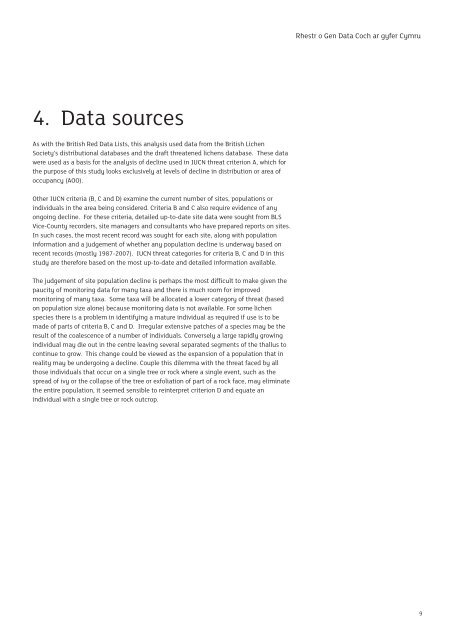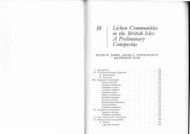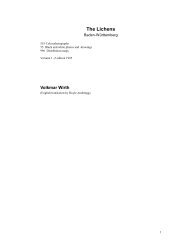Welsh Lichen Red List - Lichens of Wales
Welsh Lichen Red List - Lichens of Wales
Welsh Lichen Red List - Lichens of Wales
You also want an ePaper? Increase the reach of your titles
YUMPU automatically turns print PDFs into web optimized ePapers that Google loves.
4. Data sources<br />
As with the British <strong>Red</strong> Data <strong>List</strong>s, this analysis used data from the British <strong>Lichen</strong><br />
Society’s distributional databases and the draft threatened lichens database. These data<br />
were used as a basis for the analysis <strong>of</strong> decline used in IUCN threat criterion A, which for<br />
the purpose <strong>of</strong> this study looks exclusively at levels <strong>of</strong> decline in distribution or area <strong>of</strong><br />
occupancy (AOO).<br />
Other IUCN criteria (B, C and D) examine the current number <strong>of</strong> sites, populations or<br />
individuals in the area being considered. Criteria B and C also require evidence <strong>of</strong> any<br />
ongoing decline. For these criteria, detailed up-to-date site data were sought from BLS<br />
Vice-County recorders, site managers and consultants who have prepared reports on sites.<br />
In such cases, the most recent record was sought for each site, along with population<br />
information and a judgement <strong>of</strong> whether any population decline is underway based on<br />
recent records (mostly 1987-2007). IUCN threat categories for criteria B, C and D in this<br />
study are therefore based on the most up-to-date and detailed information available.<br />
The judgement <strong>of</strong> site population decline is perhaps the most difficult to make given the<br />
paucity <strong>of</strong> monitoring data for many taxa and there is much room for improved<br />
monitoring <strong>of</strong> many taxa. Some taxa will be allocated a lower category <strong>of</strong> threat (based<br />
on population size alone) because monitoring data is not available. For some lichen<br />
species there is a problem in identifying a mature individual as required if use is to be<br />
made <strong>of</strong> parts <strong>of</strong> criteria B, C and D. Irregular extensive patches <strong>of</strong> a species may be the<br />
result <strong>of</strong> the coalescence <strong>of</strong> a number <strong>of</strong> individuals. Conversely a large rapidly growing<br />
individual may die out in the centre leaving several separated segments <strong>of</strong> the thallus to<br />
continue to grow. This change could be viewed as the expansion <strong>of</strong> a population that in<br />
reality may be undergoing a decline. Couple this dilemma with the threat faced by all<br />
those individuals that occur on a single tree or rock where a single event, such as the<br />
spread <strong>of</strong> ivy or the collapse <strong>of</strong> the tree or exfoliation <strong>of</strong> part <strong>of</strong> a rock face, may eliminate<br />
the entire population, it seemed sensible to reinterpret criterion D and equate an<br />
individual with a single tree or rock outcrop.<br />
Rhestr o Gen Data Coch ar gyfer Cymru<br />
9





